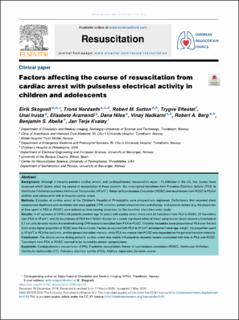| dc.contributor.author | Skogvoll, Eirik | |
| dc.contributor.author | Nordseth, Trond | |
| dc.contributor.author | Sutton, Robert M. | |
| dc.contributor.author | Eftestøl, Trygve Christian | |
| dc.contributor.author | Irusta, Unai | |
| dc.contributor.author | Aramendi, Elisabete | |
| dc.contributor.author | Niles, Dana E. | |
| dc.contributor.author | Nadkarni, Vinay M. | |
| dc.contributor.author | Berg, Robert A. | |
| dc.contributor.author | Abella, Benjamin S. | |
| dc.contributor.author | Kvaløy, Jan Terje | |
| dc.date.accessioned | 2021-02-23T12:52:32Z | |
| dc.date.available | 2021-02-23T12:52:32Z | |
| dc.date.created | 2021-01-20T20:21:19Z | |
| dc.date.issued | 2020 | |
| dc.identifier.citation | Resuscitation. 2020, 152 116-122. | en_US |
| dc.identifier.issn | 0300-9572 | |
| dc.identifier.uri | https://hdl.handle.net/11250/2729827 | |
| dc.description.abstract | Background: Although in-hospital pediatric cardiac arrests and cardiopulmonary resuscitation occur >15,000/year in the US, few studies have assessed which factors affect the course of resuscitation in these patients. We investigated transitions from Pulseless Electrical Activity (PEA) to Ventricular Fibrillation/pulseless Ventricular Tachycardia (VF/pVT), Return of Spontaneous Circulation (ROSC) and recurrences from ROSC to PEA in children and adolescents with in-hospital cardiac arrest. Methods: Episodes of cardiac arrest at the Children's Hospital of Philadelphia were prospectively registered. Defibrillators that recorded chest compression depth/rate and ventilation rate were applied. CPR variables, patient characteristics and etiology, and dynamic factors (e.g. the proportion of time spent in PEA or ROSC) were entered as time-varying covariates for the transition intensities under study. Results: In 67 episodes of CPR in 59 patients (median age 15 years) with cardiac arrest, there were 52 transitions from PEA to ROSC, 22 transitions from PEA to VF/pVT, and 23 recurrences of PEA from ROSC. Except for a nearly significant effect of mean compression depth beyond a threshold of 5.7 cm, only dynamic factors that evolved during CPR favored a transition from PEA to ROSC. The latter included a lower proportion of PEA over the last 5 min and a higher proportion of ROSC over the last 5 min. Factors associated with PEA to VF/pVT development were age, weight, the proportion spent in VF/pVT or PEA the last 5 min, and the general transition intensity, while PEA recurrence from ROSC only depended on the general transition intensity. Conclusion: The clinical course during pediatric cardiac arrest was mainly influenced by dynamic factors associated with time in PEA and ROSC. Transitions from PEA to ROSC seemed to be favored by deeper compressions. | en_US |
| dc.language.iso | eng | en_US |
| dc.publisher | Elsevier | en_US |
| dc.rights | Navngivelse 4.0 Internasjonal | * |
| dc.rights.uri | http://creativecommons.org/licenses/by/4.0/deed.no | * |
| dc.title | Factors Affecting the Course of Resuscitation From Cardiac Arrest With Pulseless Electrical Activity in Children and Adolescents | en_US |
| dc.type | Peer reviewed | en_US |
| dc.type | Journal article | en_US |
| dc.description.version | publishedVersion | en_US |
| dc.source.pagenumber | 116-122 | en_US |
| dc.source.volume | 152 | en_US |
| dc.source.journal | Resuscitation | en_US |
| dc.identifier.doi | 10.1016/j.resuscitation.2020.05.013 | |
| dc.identifier.cristin | 1876029 | |
| dc.description.localcode | /© 2020 TheAuthor(s). Published by Elsevier B.V. This is an open access article under the CC BY license (http://creativecommons.org/licenses/ by/4.0/).This is an open access article under the CC BY license (http://creativecommons.org/licenses/by/4.0/) | en_US |
| cristin.ispublished | true | |
| cristin.fulltext | original | |
| cristin.qualitycode | 2 | |

